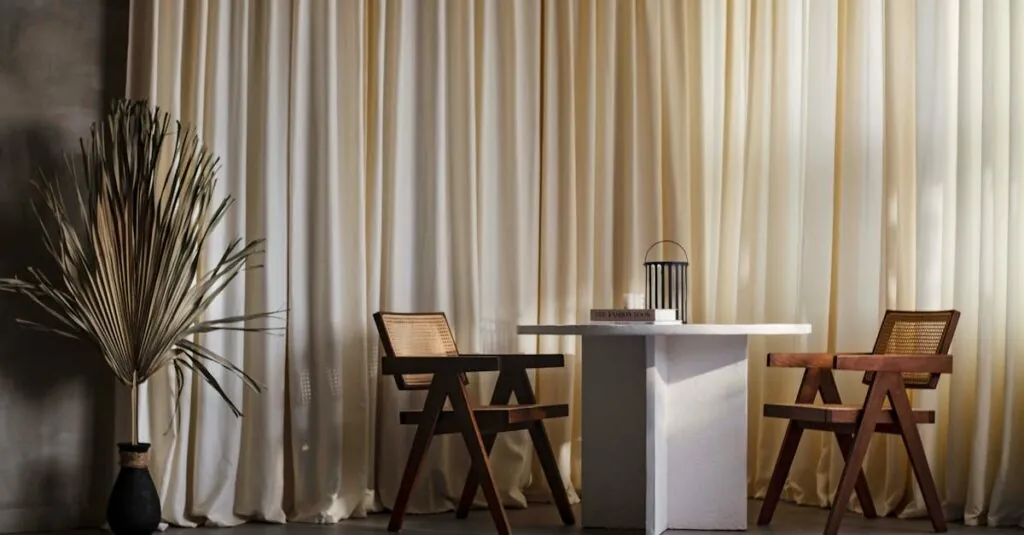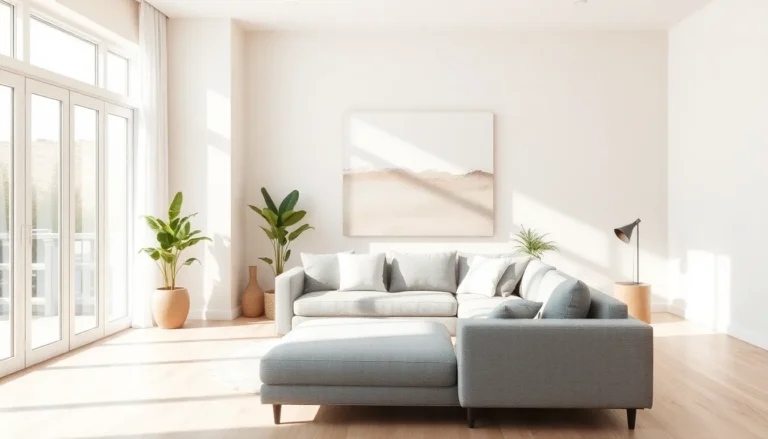Table of Contents
ToggleImagine a living room so serene it could make a zen master weep. That’s the magic of Japandi living, where minimalist design meets the cozy charm of Japanese and Scandinavian aesthetics. It’s not just about less clutter; it’s about creating a sanctuary that whispers tranquility while still being stylish enough to impress even the pickiest of guests.
Understanding Minimalist Lifestyle
Minimalist lifestyle embodies simplicity and intentionality. It encourages individuals to declutter their spaces and focus on what truly matters. Creating an environment that promotes peace, efficiency, and functionality drives this lifestyle. A person embraces both physical and mental clarity by reducing excess and distractions.
Adopting a minimalist approach involves evaluating possessions and eliminating items that do not provide value or joy. Individuals often prioritize quality over quantity, investing in fewer, high-quality items. This mindset supports sustainable living by minimizing waste and encouraging thoughtful consumption.
Minimalism extends beyond physical spaces; it influences daily routines and mindsets. Practicing mindfulness plays a significant role, as individuals learn to appreciate the present moment. Enhanced calmness and improved focus result from minimizing external chaos.
Japandi living rooms exemplify minimalist lifestyle principles. The blend of Japanese and Scandinavian aesthetics emphasizes simplicity while focusing on natural materials and functional design. Neutral color palettes dominate, creating serene atmospheres that invite relaxation. Clean lines and organic textures characterize furniture choices, enhancing the tranquility of the space.
Furthermore, plants and natural elements contribute to the overall aesthetic. Incorporating greenery fosters a connection with nature and promotes mindfulness. This integration aligns with the minimalist goals of promoting wellness and serenity.
Overall, minimalist lifestyle prioritizes clarity, balance, and well-being. The Japandi style serves as a practical application, illustrating how these principles create harmonious, inviting living spaces.
What Is Japandi Design?
Japandi design merges Japanese minimalism with Scandinavian warmth, creating serene living environments. This style emphasizes simplicity, functionality, and natural beauty, appealing to those seeking harmony in their homes.
Key Features of Japandi Style
Natural materials like wood and bamboo dominate Japandi spaces. Neutral color palettes establish a calming atmosphere, while clean lines enhance the sense of order. Functional furniture serves practical needs without sacrificing aesthetics. Minimal decor keeps the focus on quality over quantity, encouraging intentionality in design choices. Additionally, thoughtful placement of plants establishes a connection with nature, fostering a soothing environment.
The Blend of Japanese and Scandinavian Aesthetics
Japanese influences bring elegance and a focus on craftsmanship. Scandinavian elements contribute warmth and comfort through inviting textiles and soft shapes. Form follows function in both cultures, ensuring that each piece serves a purpose. Open spaces encourage natural light and airiness, vital in both traditions. The combination creates a unique balance of tranquility and style, appealing to those who appreciate both approaches in their living spaces.
Creating a Japandi Living Room
Crafting a Japandi living room involves harmonizing minimalist aesthetics with practicality. Key aspects include color selection and furniture choices.
Choosing the Right Color Palette
Neutral tones define the Japandi color palette. Soft shades of beige, gray, and white promote tranquility and lightness. Adding muted greens or earthy tones enhances a natural connection. Contrast remains subtle yet effective, avoiding overwhelming visual elements. Textiles and accessories can introduce brief color accents, maintaining harmony without clutter.
Essential Furniture for a Minimalist Japandi Living Room
Functional furniture plays a pivotal role in Japandi design. Low-profile sofas and streamlined coffee tables maximize space while offering comfort. Natural materials such as wood and bamboo provide warmth and aesthetic appeal. Incorporating multi-functional pieces, like storage ottomans or extendable dining tables, aligns with minimalist principles. Consider designs that prioritize clean lines and simplicity, ensuring the space remains spacious and serene.
Decor Tips for a Minimalist Lifestyle
Creating a minimalist living room requires thoughtful design choices that embody serenity and functional beauty. Focusing on key aspects enhances the overall ambiance.
Incorporating Natural Elements
Natural elements play a significant role in Japandi design. Integrating wood features like furniture and accent decor creates warmth. Using indoor plants contributes to a calming atmosphere and connects the space with nature. Opt for simple, unadorned planters made from clay or ceramic. Selecting soft textiles, such as linen or wool, enhances comfort while maintaining a clean aesthetic. Prioritizing a few large plants over multiple smaller ones maintains an uncluttered look. A well-placed bonsai or succulent serves as a focal point, adding visual interest without overwhelming the space.
Practical Storage Solutions for a Clutter-Free Space
Effective storage solutions streamline organization in a minimalist living room. Incorporating multifunctional furniture, such as storage ottomans or coffee tables with hidden compartments, optimizes space. Wall-mounted shelves offer an opportunity to display decorative items while keeping the floor area open. Baskets crafted from natural fibers add texture and provide discreet storage for blankets or magazines. Consider using vertical storage units, which draw the eye upward and create the illusion of a larger room. Keeping surfaces clear of unnecessary items promotes tranquility and focus, essential components of a minimalist lifestyle.
Embracing a Japandi living room not only enhances aesthetic appeal but also fosters a sense of peace and mindfulness. This design style encourages individuals to curate their spaces thoughtfully by prioritizing quality and natural elements. With its blend of Japanese minimalism and Scandinavian warmth, Japandi creates an inviting atmosphere that promotes well-being.
By adopting a minimalist lifestyle, one can experience clarity and tranquility in both their environment and daily routines. The intentional choices made in decor and furniture reflect a commitment to simplicity and functionality, allowing for a harmonious living space. Ultimately, Japandi living rooms exemplify how minimalist principles can transform a home into a serene sanctuary.







